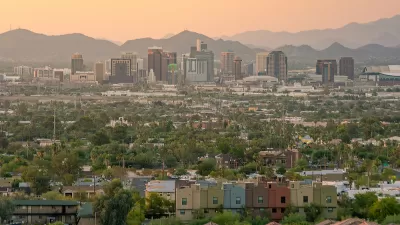Nashville is the latest city to enact a substantive change to the parking requirements set by the city’s zoning code—doing away with parking minimums and setting parking maximums in the city’s Urban Zoning Overlay.

The Nashville City Council approved a bill that will replace the city’s downtown parking minimums with parking maximums in the zoning code. The city is the latest to implement changes to its parking regulations in a wave of reform—Cambridge, Ann Arbor, Cincinnati, California, and Oregon have approved historic parking reforms in the second half of 2023.
Previously in Nashville, “property owners and developers seeking permits were required to provide a minimum number of on-site parking spaces. Under the new ordinance, those old parking space minimums have become the new maximum number of spaces allowed for developments on urban-zoned land,” according to an article by Cassandra Stephenson reporting on the change.
“The changes impact Nashville's "Urban Zoning Overlay," an area stretching from East Nashville to Interstate 440 and from Hillwood to portions of South Nashville. Most of the land in this area lies within a quarter mile of bus service lines offered by WeGo, Nashville's public transit system,” adds Stephenson.
The ordinance was approved with the support of politicians and planners. Some opposition was reported among councilmembers who say that the city’s public transit system is not robust enough to reduce parking in downtown. Some residents opposed the change out of concern about spillover parking in nearby residential neighborhoods.
A lot more detail about the ordinance and the surrounding political debate are included at the link below.
FULL STORY: Nashville eliminates minimum parking space requirements in urban areas

Trump Administration Could Effectively End Housing Voucher Program
Federal officials are eyeing major cuts to the Section 8 program that helps millions of low-income households pay rent.

Planetizen Federal Action Tracker
A weekly monitor of how Trump’s orders and actions are impacting planners and planning in America.

Ken Jennings Launches Transit Web Series
The Jeopardy champ wants you to ride public transit.

Washington Legislature Passes Rent Increase Cap
A bill that caps rent increases at 7 percent plus inflation is headed to the governor’s desk.

From Planning to Action: How LA County Is Rethinking Climate Resilience
Chief Sustainability Officer Rita Kampalath outlines the County’s shift from planning to implementation in its climate resilience efforts, emphasizing cross-departmental coordination, updated recovery strategies, and the need for flexible funding.

New Mexico Aging Department Commits to Helping Seniors Age ‘In Place’ and ‘Autonomously’ in New Draft Plan
As New Mexico’s population of seniors continues to grow, the state’s aging department is proposing expanded initiatives to help seniors maintain their autonomy while also supporting family caregivers.
Urban Design for Planners 1: Software Tools
This six-course series explores essential urban design concepts using open source software and equips planners with the tools they need to participate fully in the urban design process.
Planning for Universal Design
Learn the tools for implementing Universal Design in planning regulations.
Heyer Gruel & Associates PA
Ada County Highway District
Institute for Housing and Urban Development Studies (IHS)
City of Grandview
Harvard GSD Executive Education
Toledo-Lucas County Plan Commissions
Salt Lake City
NYU Wagner Graduate School of Public Service





























